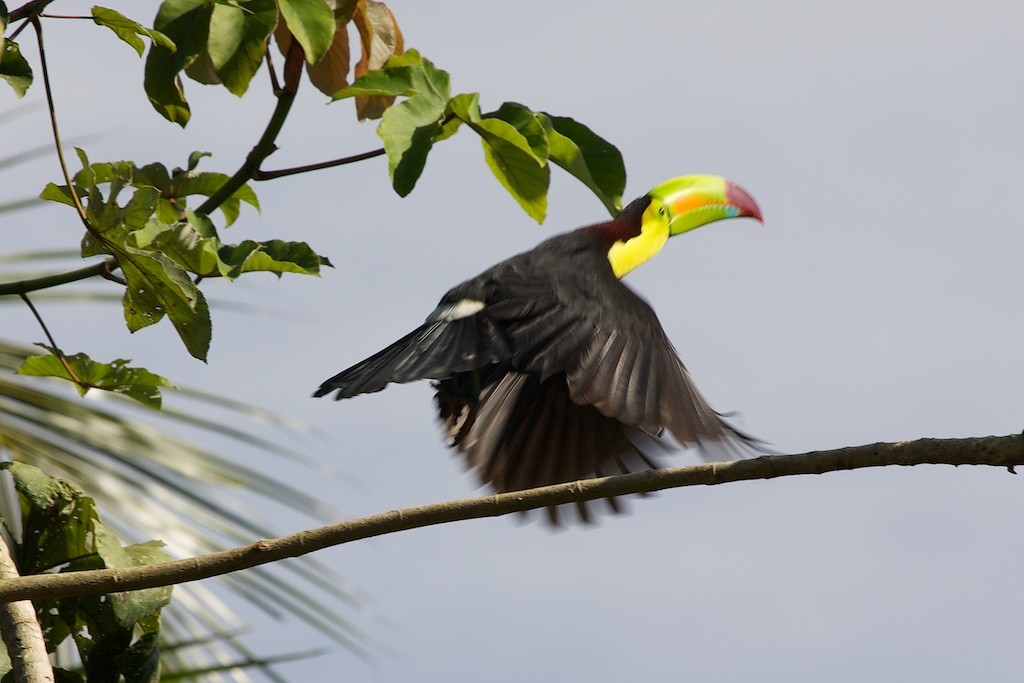Keel-billed Toucan
A species of Typical Toucans, Also known as Rainbow-billed Toucan Scientific name : Ramphastos sulfuratus Genus : Typical Toucans
Keel-billed Toucan, A species of Typical Toucans
Also known as:
Rainbow-billed Toucan
Botanical name: Ramphastos sulfuratus
Genus: Typical Toucans
Content
Description People often ask General Info
Description
Including its bill, the keel-billed toucan ranges in length from around 42 to 55 cm (17 to 22 in). Their large and colorful bill averages around 12–15 cm (4.7–5.9 in), about one-third of its length. It typically weighs about 380–500 g (13–18 oz). While the bill seems large and cumbersome, it is in fact a spongy, hollow bone covered in keratin, a very light and hard protein. The plumage of the keel-billed toucan is mainly black with a yellow neck and chest. Molting occurs once per year. It has blue feet and red feathers at the tip of its tail. The bill is mainly green with a red tip and orange sides. Keel-billed toucans have zygodactyl feet (or feet with toes facing in different directions) – two toes face forward and two face back. Because toucans spend a large portion of time in the trees, this helps the birds to stay on the branches of the trees and jump from one branch to another. 
Size
51 cm
Life Expectancy
15-20 years
Nest Placement
Cavity
Feeding Habits
Keel-billed Toucan primarily consumes a variety of fruits and seeds. Occasionally, it supplements its diet with animal protein, including the eggs and nestlings of small passerines. Its foraging technique involves utilizing its large bill to reach and procure food, exhibiting a preference for juicy fruits.
Habitat
Keel-billed Toucan resides primarily in humid lowland forests within the canopy layer, favoring open rainforests and second-growth woodlands. These birds are adaptable, often inhabiting agricultural areas like cacao and coffee plantations and residing in riverine forests in drier climates. Adapted to tropical regions with year-round lush vegetation, keel-billed Toucan frequents areas sustained by a consistent water table, including forest remnants and disturbed habitats near forest edges.
Dite type
Frugivorous
People often ask
General Info
Feeding Habits
Bird food type

Fruit
Behavior
Like many toucans, keel-billed toucans are very social birds, rarely seen alone. They fly in small flocks of approximately six to twelve individuals through lowland rainforests. Their flight is slow and undulating, consisting of rapid wing beats (six to ten), then a glide with the bird's beak extending forward and dipping downward as though pulling the rest of the bird. Their feet are drawn up forward in flight. The flight distances are typically short. They live together in groups, often sharing cramped living quarters of holes in trees. There is a family structure within the group. Birds often "duel" with each other using their bills, and throw fruit into each other's mouths. They 'play ball', one throwing a fruit in the air and a second seizing it. 
Distribution Area
The keel-billed toucan can be found from Southern Mexico to Venezuela and Colombia. It roosts in the canopies of tropical, subtropical, and lowland rainforests, up to altitudes of 1,900 m (6,200 ft). It roosts in holes in trees, often with several other toucans. This can be very cramped, so the birds tuck their tails and beaks under their bodies to conserve space while sleeping. Adding to the lack of space, the bottoms of the holes are often covered with pits from the fruit the toucans have eaten. 
Species Status
Not globally threatened.
